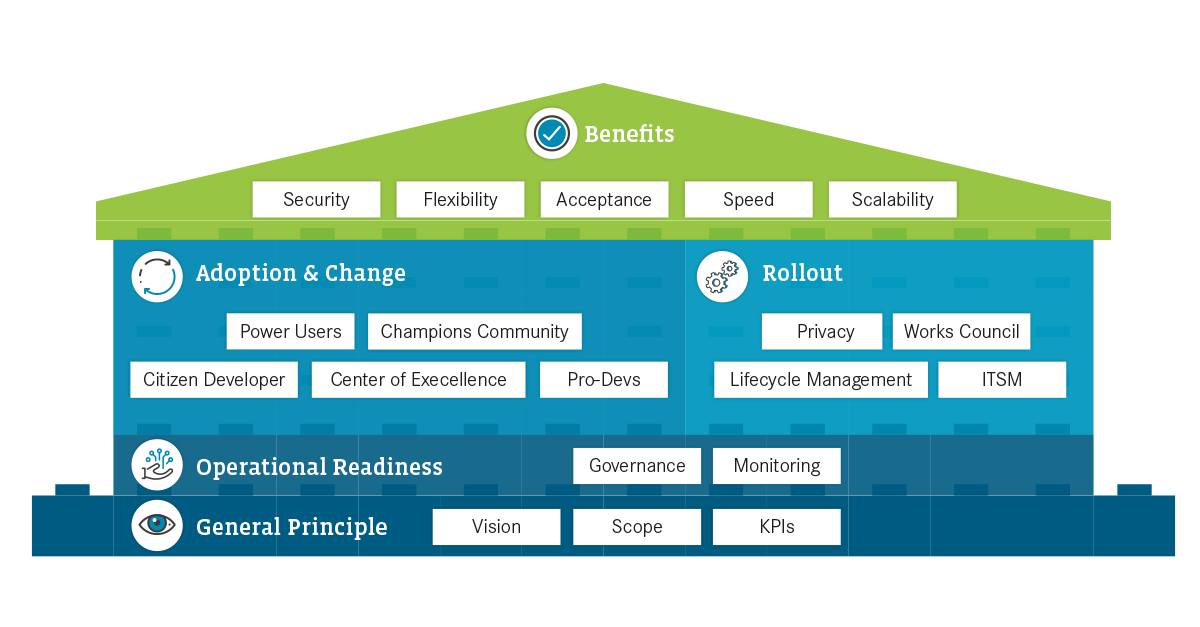More and more employees expect that their workplaces provide them with the kind of simple and practical apps that they can access on their personal devices. Now, new platforms – which we presented here – provide the option of designing their own customized applications. However, it is important to pay attention to a few items to avoid uncontrolled growth.
A warehouse worker is on her way to work. She takes a picture of the fabulous sunrise and uploads it onto Instagram. When she arrives at work: The first delivery has a couple of damaged parts. The damage has to be documented correctly, which means that she has to fill out a paper form by hand and she has to get the camera from the office to take a picture. Then she has to transfer the photo by USB and e-mail it to the colleagues in charge. The form is still sent the old-fashioned way, namely by in-house mail. And then she has to wait a few days for a confirmation or feedback. In the meantime: 43 Likes on Instagram.
The gap between private apps and conventional business processes continues to grow. No wonder employees are increasingly pushing for new solutions. But they are often hampered by IT departments that have to solve important issues before such solutions can be introduced, e.g. GDPR compliance, process integration and general responsibilities. This means that the path to a new app is a cumbersome and protracted process.
Growing pressure due to the advance of digitization
This gulf between desire and reality creates frustration among all parties involved. And the pressure is growing during the current corona situation, which is causing more work processes to be digitized. Companies have recognized this contrast between modern apps and traditional work processes. And yet, large company-wide programs such as “Enterprise Agility”, “Strengthening Business-IT Alignment” or a “Digital Strategy 2025” are often designed and initiated from within the company's ivory tower. The result: Actions that ignore the expectations and needs of employees and that are not accepted into daily work routines – or they simply take too long.
Digital employees, on the other hand, want to become digital designers and immediately implement practical solutions that support them in their daily processes. In particular, they are interested in increasing efficiency and productivity. But often they lack the opportunities or skills to do this. And so, they may go and get the required applications on their own. The result: uncontrolled shadow IT.
This is exactly where companies need to take action. They must be able to provide digital employees with the tools and skills that turn them into digital designers. This process is accompanied by a cultural transformation, adjustments to organizational forms and processes, and the introduction of a suitable set of tools, such as a low-code platform.
The advantages of a low-code platform
A low-code platform enables the development of applications using visual and graphics functions instead of the conventional text-based programming techniques. In this way, the process of developing new apps is not only faster, but also easier. What this means: You do not always need an IT expert to build an app. Now, qualified employees in the department can design their own app from templates and adjust them to their needs. This process is often referred to as Citizen Development.
And it is not just “another platform”. Rather, it forms an important building block for making the company more agile. Because low-code platforms can be used to address requirements where they originate - namely the person requesting a new app. This relieves the pressure on IT, provides departments with flexibility and speed, and truly leverages the company's innovative capacity.
Benefits for employees
Besides these general advantages for the company itself, digital employees also enjoy a number of concrete benefits. Now engaged business users in the departments, who implement the corresponding processes on a daily basis, can design their apps by themselves. After all, they know best where the problems are, and how they can be solved.
And they are able to tailor their apps exactly to their needs. This increases acceptance of the solutions, as employees are able to address their requirements on their own. In addition, changes can be implemented quickly and the advantages become visible right away, in contrast to large programs. Similarly, adjustments and optimizations are only a few clicks away (without the need for multiple meetings and coordination). The cost of implementing simple applications declines not just for the department but also for the IT department.
Benefits for the IT department
The IT department also benefits from the introduction of a low-code platform. When departments request small apps, the ratio between coordination and actual development is often 60 to 40 percent or worse. If the department can create these apps on its own, the IT team has more time to focus on the essentials: the secure operation of the platform, governance, advisory services and “hard code development”.
This relieves the pressure on the IT department as costly coordination activities for detailed requirements such as the customary requests for “color”, “placement” and the form of the functions or the testing requirements are shifted directly to the party requesting the app. Consequently, follow-up requirements, complaints and the resulting claims management are also reduced or disappear altogether.
Criteria for introducing Citizen Development
However, a few requirements must be met before such a low-code platform and the associated Citizen Development Services can be introduced. They relate not so much to the technical but the organizational side of this process. For example, the relevant responsibilities and processes must be changed or adjusted. The following items should be considered in this context:
- Analysis of the starting situation: How large is the demand for apps? What are the specific pain points? What will generate the greatest benefit?
- Definition of personas: Who can be a “requester”? What is the required skill set for a requester? What are the obligations that accompany this role?
- Define the applications cases for which apps may be developed: For example, should processes that are critical to the business and the productivity area be excluded? What about interfaces to third-party systems or sensitive data?
- Integration into the IT strategy: Which platforms already exist? Which low-code platforms should be introduced?
- Define KPIs for controlling purposes: How should the success of Citizen Development be measured?
- Define roles: Which parties are involved? What are the responsibilities of IT and the department? Is there a Center of Excellence that e.g. identifies Best Practices and implements them across the company?
- Develop a governance concept: Prevent data loss, enable scalability and integration.
- Operational handbook: to secure operations.
- Monitoring: an essential component to prevent uncontrolled app growth.
- Providing the appropriate tool set: Using the digital workplace as a basis, integrated applications and platforms should be used to support processes.
- Meeting requirements: The tool set should be fast, flexible, easy to use, scalable and secure, and it should be integrated into the digital workplace.
- Involving the works council, data protection officer and CSIO: This step should be started very early and continuously updated.
- IT demand processes: Many companies already practice a requirements process. The low-code platforms must be smoothly integrated into this process. This may result in “make or buy” decisions.
- IT Service Management: For example, users must have someone to turn to when they have problems, for example a Service Desk.
- Create beacons: Their purpose is to demonstrate the added value to employees, IT and management.
- Establish a Center of Excellence as the “functional owner” of the platform.
- Train Citizen Developers and/or Power Users. Involve professional developers directly and promote a transparent exchange process.
- Establish a Champions Community: It can operate the tool set in the best way possible and generates additional benefits.
Possible hurdles
Often, the implementation of low-code platforms is accompanied by a number of errors that can be easily avoided. We always start with a concept. It does not take a lot of time and can be developed as a working hypothesis in a one-day workshop. It also focuses the benefit of the platform: It does not make sense to set up an entire low-code platform for a single application. Often, we also conduct Use-Case-Discovery Workshops or Envisioning sessions to define the demand for Citizen Development.
We notice that the employees involved are often forgotten. Just because someone has PowerPoint does not mean that they can create a good presentation. Here, we use the appropriate change management process to protect the investment in the platform and realize the benefits. In this vein, we also eliminate outdated assumptions, for example that only IT can create new apps or that users would be overwhelmed.
Often, we also notice the unchecked proliferation of apps created by departments, which results in uncontrolled growth. Or prototypes that turn into beacon projects, which are transferred to live operations. Without rules at the meta level and integration into IT service management, the platform will “explode”. These are just a few steps that we use to protect the platform.


